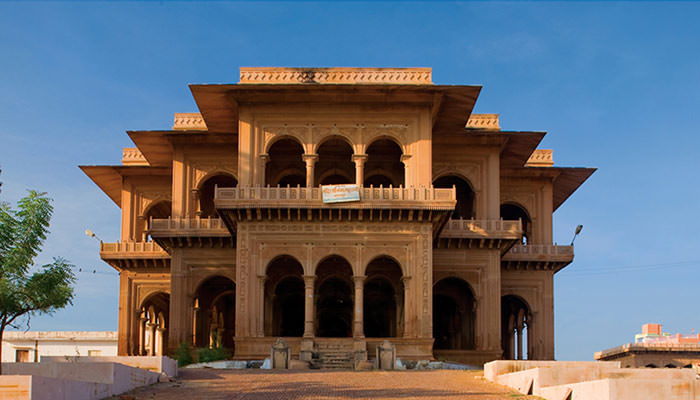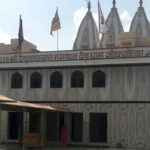Discovering the Majestic Ganga Maharani Temple in Bharatpur
In the lively city of Bharatpur, Rajasthan, the Ganga Maharani Temple stands as a gorgeous tribute to the magnificent Goddess Ganga. With its intricate design and spiritual relevance, this temple is not simply a church but also an icon of social heritage and history. This article explores the rich history, architectural charm, and spiritual ambiance of the Ganga Maharani Temple, providing a comprehensive guide for travelers and followers alike.
A Glimpse into History
The Ganga Maharani Temple was constructed by Maharaja Balwant Singh of Bharatpur in 1845. Dedicated to Goddess Ganga, the temple symbolizes the Maharaja’s commitment and the city’s cultural connection to the river goddess, revered in Hindu mythology as the cleanser of transgressions and sustainer of life. The building of the temple marked a significant era in Bharatpur’s history, mirroring the royal lineage’s dedication to maintaining spiritual and cultural traditions.
Over the years, the temple has been a pilgrimage destination for devotees across India. It stands as a testament to the Jat dynasty’s architectural and cultural tradition. The temple’s historical value is further highlighted by its role in the city’s cultural and spiritual activities, making it a vital part of Bharatpur’s heritage.
Architectural Elegance
The Ganga Maharani Temple is a building wonder, blending typical Rajasthani and Mughal styles. The temple’s structure features detailed carvings and beautiful sculptures, exciting visitors with its creative luster. The temple complex, built on an elevated platform, is surrounded by magnificently landscaped gardens, providing a peaceful setting for reflection and contemplation.
Upon entering, visitors are greeted by an elaborately sculpted archway leading to the sanctum sanctorum, where the idol of Goddess Ganga is preserved. Crafted from white marble, the idol exhibits purity and divinity. The temple’s façade is adorned with detailed carvings portraying different deities and mythological scenes, showcasing the craftsmanship of the era.
The walls and ceilings are embellished with vibrant frescoes and paintings, illustrating scenes from Hindu mythology and adding to the temple’s visual charm. The temple also boasts a grand dome, a characteristic feature of Mughal architecture, decorated with delicate carvings. At the dome’s peak sits a kalash (sacred pot), symbolizing prosperity and auspiciousness in Hindu society.
Spiritual Relevance
The Ganga Maharani Temple holds profound spiritual importance for Hindus. Goddess Ganga, worshiped as the goddess of purification, is believed to cleanse the sins of those who seek her blessings. Devotees visit the temple to offer prayers and seek blessings for health, prosperity, and spiritual wellness.
The temple is also a focal point for various religious events and festivals. Among the most significant events celebrated here is Ganga Dussehra, commemorating Goddess Ganga’s descent from heaven to earth. During this event, the temple is beautifully decorated, and devotees gather to participate in special rituals and prayers, invoking the goddess’s blessings.
Another major celebration is the annual Navratri festival, a nine-day event dedicated to the nine forms of the goddess. The temple becomes a hub of spiritual activities, with enthusiasts engaging in rituals such as offering flowers, lighting lamps, and chanting hymns. The temple also hosts community meals (bhandaras) during these events, where devotees partake in prasadam (sacred food) offered to the goddess, fostering a sense of community and devotion.
A Location of Tranquility and Contemplation
Beyond its architectural beauty and spiritual importance, the Ganga Maharani Temple offers a tranquil environment for visitors. The temple’s serene surroundings, with lush gardens and the soothing sound of temple bells, provide an ideal setting for meditation and introspection. The temple’s peaceful ambiance attracts not only devotees but also tourists seeking solace and a break from the hustle and bustle of everyday life.
The well-maintained gardens surrounding the temple are an excellent location for a leisurely walk. The breathtaking beauty and the scent of blooming flowers add to the temple’s calming effect, making it a popular place for visitors to relax and unwind. The temple’s ambiance encourages a reflective and contemplative state of mind, making it a unique destination for spiritual seekers and cultural enthusiasts.
Visiting the Ganga Maharani Temple
The Ganga Maharani Temple is centrally located in Bharatpur, making it easily accessible to visitors. The temple welcomes followers and tourists year-round, with special arrangements made during celebrations and religious events. The best times to visit are early morning or late evening when the temple is less crowded, and the environment is most tranquil.
Visitors are advised to dress decently and adhere to the temple’s customs and practices. Photography is generally permitted within the temple premises, but visitors must respect the sanctity of the temple and seek permission before taking photographs inside the sanctum sanctorum. This respect for tradition and decorum enhances the overall experience, allowing visitors to connect with the temple’s spiritual significance.
Conclusion
The Ganga Maharani Temple in Bharatpur is more than just a place of worship; it is a symbol of cultural heritage, architectural splendor, and spiritual dedication. Its rich history, exquisite architecture, and tranquil atmosphere make it a must-visit destination for anyone exploring Bharatpur. Whether you are a devotee seeking blessings or a traveler interested in the historical and cultural wealth of Rajasthan, the Ganga Maharani Temple offers a unique and enriching experience that leaves a lasting impression on the mind and spirit.
For a deeper exploration of Rajasthan’s treasures, including the best travel packages and accommodations, visit Rajasthan Tour Packages. This temple, with its rich legacy and peaceful environment, stands as a testament to Bharatpur’s enduring cultural and spiritual heritage, offering visitors a glimpse into the city’s vibrant past and spiritual depth.
8 Concerns and Solutions regarding the Ganga Maharani Temple in Bharatpur
Q1.: What is the Ganga Maharani Temple, and where is it located?
A : The Ganga Maharani Holy place is an adored Hindu temple committed to Siren Ganga, situated in Bharatpur, Rajasthan, India. It is known for its intricate layout, spiritual significance, and cultural heritage.
Q2.: That constructed the Ganga Maharani Holy Place, and when?
A : The temple was created by Maharaja Balwant Singh of Bharatpur in 1845. It stands as a testament to the Maharaja’s dedication and the city’s social connection to the river goddess Ganga.
Q3.: What building styles are shown in the temple’s layout?
A : The Ganga Maharani Temple mixes standard Rajasthani and Mughal architectural styles. The structure features complex makings, stunning sculptures, vivid frescoes, and a grand dome, decorated with delicate designs.
Q4.: What is the spiritual significance of the holy place?
A : The holy place holds extensive spiritual significance for Hindus. Siren Ganga is worshiped as the siren of purification, believed to cleanse the transgressions of devotees. The holy place is a focal point for numerous religious ceremonies and events, such as Ganga Dussehra and Navratri.
Q5.: What are a few of the crucial celebrations celebrated at the temple?
A : Key events commemorated at the Ganga Maharani Temple consist of Ganga Dussehra, which honors the descent of Siren Ganga to earth, and Navratri, a nine-day event devoted to the siren. Throughout these events, the holy place is beautifully decorated, and unique routines and petitions are done.
Q6.: What are the functions of the temple’s surroundings?
A : The holy place is surrounded by beautifully designed gardens, supplying a serene setting for reflection and representation. The well-kept yards give a serene setting, making it a prominent spot for site visitors to loosen up and unwind.
Q7.: What is the most effective time to visit the Ganga Maharani Holy Place?
A : The very best times to visit the temple are early morning or late evening when it is less congested and the atmosphere is most serene. These times allow site visitors to totally experience the holy place’s peaceful and spiritual setting.
Q8.: Exist any standards for visitors to the holy place?
A : Visitors are advised to clothe decently and value the holy place’s customizeds and methods. Digital photography is typically permitted within the temple facilities, but visitors should look for authorization prior to taking pictures inside the sanctum sanctorum. This regard for practice improves the overall experience and connection with the temple’s spiritual significance.
These concerns and solutions give a comprehensive understanding of the Ganga Maharani Holy place, highlighting its historic, architectural, and spiritual significance.



